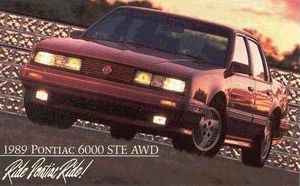.
Pontiac 6000

| |
| Pontiac 6000 | |
|---|---|
| Pontiac | |
| Production | 1982-1991 |
| Class | Intermediate |
| Body Style | 2-Door Coupe 4-Door Sedan 5-Door Wagon |
| Length | 188.9" |
| Width | 72" |
| Height | 53.7" |
| Wheelbase | 104.9" |
| Weight | 3100-3400 lbs |
| Transmission | 3-Speed Automatic, FWD/AWD 4-Speed Automatic, FWD 5-Speed Manual |
| Engine | 2.5L (151 cid) I4 (1982-1991) 2.8L (173 cid) V6 (1982-1989) 3.1L (191 cid) V6 (1988-1991) 4.3L (262 cid) Diesel V6 (1982-1985) |
| Power | 90-140 hp |
| Similar | Buick Century Chevrolet Celebrity Oldsmobile Cutlass Ciera |
| Platform | A |
Pontiac introduced the A-body 6000 in 1982 as a replacement for the departed rear-drive LeMans, and was built on the same 104.9" front wheel drive X-body Phoenix chassis and drivetrain. The 6000 was offered along with its corporate mates, the Buick Century, Chevrolet Celebrity and Oldsmobile Cutlass Ciera, and while those cars catered to a more conservative crowd, Pontiac fancied the 6000 as a quasi-alternative to Audi and BMW sport sedans - a lofty goal indeed. It would be offered thru the end of the 1991 model year.
Here's a quick rundown:
1982-1991
When the 6000 was first introduced in 1982, there were coupe and sedan bodystyles, with two trim levels: base and LE. Both offered the Phoenix's standard 2.5L Iron-Duke four cylinder engine, using throttle body injection, and produced 90 horsepower and 125 lb/ft of torque. Optional was GM's 2.8L V6 engine, using a 2-barrel carburetor, producing 112 horsepower and 135 lb/ft of torque, as well as an optional 4.3L Diesel V6 supplied by Oldsmobile, producing 83 horsepower. A 3-speed automatic transmission was the sole transmission option.
For 1983, the base and LE models were accompanied by a new STE model. The STE was designed to take on European road cars from Audi, BMW and Mercedes-Benz, for about half the cost. Standard was a high-output 2.8L V6 sporting a 2-barrel carburetor. This engine produced 135 horsepower and 165 lb/ft of torque, with a standard floor mounted 3 speed automatic transmission. The STE set itself apart from other 6000s by offering a unique front fascia with integrated fog lamps for a 6 headlamp look. At the rear, a full width lightbar enhanced its Euro-sedan look. Underneath, an upgraded suspension, wider and stickier tires and a mellow exhaust gave the STE the European feel. Inside, the STE used wider and more supportive bucket seats with available 8-way power adjustment for both driver and front passenger seats, an upgraded stereo and a driver information center. However, the STE still used the basic 6000-style dash which, along with the carbureted engine (most US market European sedans featured fuel injection), made the STE seem rather deficient when compared to its intended competition. For 1984, a wagon was added to all models save the STE, and the STE now featured a digital dashboard featuring full instrumentation.
In 1985, the STE's high-output V6 now sported multi-port fuel injection, increasing horsepower to 140 and torque to 170 lb/ft. The 2.5L engine had an increase in horsepower to 92. In 1986, the diesel engine was dropped and all remaining engines were now fuel injected. A 4 speed automatic transmission was available with the 2.8L V6. The STE model also now featured composite headlamps, a further upgraded stereo with innovative steering wheel controls (a Pontiac innovation that would later make it's way onto almost every car today) and anti-lock brakes. In 1987, all 6000s received new front ends with composite headlamps, the 2.5L engine got an increase in horsepower to 98, an S/E model was added with much of the STE styling and powertrain, but less standard equipment and the STE gained a memory for the driver's seat.
For 1988, all-wheel-drive was added as an option for the STE, with the addition of a new engine. When all-wheel-drive was ordered, the 2.8L was replaced by a 3.1L (191 cid) V6 producing 140 horsepower and 185 lb/ft of torque. Although the front-wheel-drive version used a 4 speed automatic, the all-wheel-drive version only used a 3 speed automatic. In 1989, the STE was only offered with all-wheel-drive, and mid year the 2.5L gained balance shafts and an increase in horsepower to 110. The rear window of all 6000s was redesigned with a rounder look. For 1990, the STE trim was dropped and moved to the Grand Prix sedan, and the S/E model inherited the AWD option, and the 2.8L V6 was dropped as the 3.1L expanded to front-wheel-drive 6000 models, with an available 4 speed automatic. For 1991, the SE and AWD models were dropped. The 6000 didn't return for the 1992 model year.
